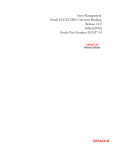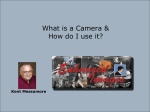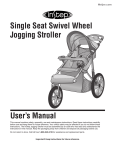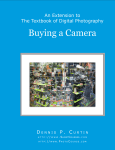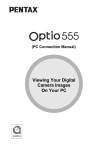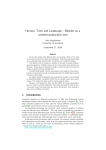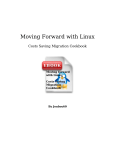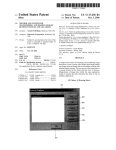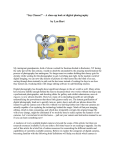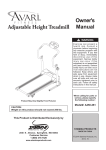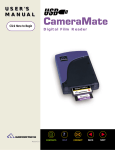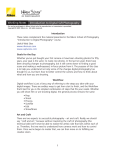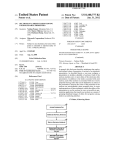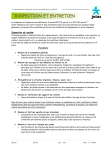Download Digital Photography Basics
Transcript
Digital Photography Basics Kent Messamore 9/5/2011 Snapshot versus Photograph Snapshot is taken without much thought Photograph - composed by Photographer Photo – “Light” Graph – “to write or draw” JKM 9/5/2011 Enhanced Images 2 Types of Cameras Cell Phone (Not allowed) Compact (Point & Shoot) Midrange (Bridge) Single Lens Reflex (SLR) JKM 9/5/2011 Enhanced Images 3 Point & Shoot Advantages versus Disadvantages Advantages Easy to operate Camera adjusts setting automatically Scene Modes to set camera controls to match situation Disadvantages Lens is smaller & therefore less light To get good exposure shutter must be open longer JKM 9/5/2011 Enhanced Images 4 Exposure The amount of light that hits the sensor (Exposure) is controlled by: - the size of the Aperture -How long the shutter is open (shutter speed) -Another factor in Exposure is the sensitivity to light of the camera Sensor (ISO) JKM 9/5/2011 Enhanced Images 5 Quantity of Light Quantity of light is an absolute. It can be measured by your camera very accurately Quantity of light is called Exposure Exposure can be controlled either Automatically in your camera or Manually. Accurate Exposure makes the difference between a good photograph and a bad photograph JKM 9/5/2011 Enhanced Images 6 Exposure Quantity of Light or Exposure is controlled by three factors: How sensitive to light is the sensor in your camera? ISO Aperture or f/stop How fast does the shutter in your camera open and close Quantity of Light How wide is the lens opening in your camera? Shutter Speed Accurate Exposure can be achieved by more than one selection of these three controls JKM 9/5/2011 Enhanced Images 7 Characteristics of Digital Cameras Low end Point & shoot. $75 - $500 Zoom Lens 4x to 9x (35 to 135 mm; 35 to 300 mm) Resolution 300-600 mp – don’t pay for more as you probably won’t print greater than 8x10 print Resolution needed for print sizes Maximum size for good prints Display size on a computer monitor Size of image file, which in turn affects how storage space to hold the file Don’t pay for a lot of extras (such as RAW format) as you probably won’t use them, or if you do, you won’t be satisfied with the results Major advantages of P&S over DSLR are, small size & quick snapshots Make sure you get a Manual control capability (aperture, shutter, ISO) Resolution (megapixels) Avg. quality Best quality .5 mp 3x5 in. N/A 2 mp 8x10 in. 3x5 in. 4 mp 11x14 in. 5x7 in. 6 mp 16x20 in. 8x10 in. 8 mp 20x30 in. 11x14 in. 10+ mp 25x40 in. 13x17 in Mid-range Point & Shoot $500 to $1000 These are basically point & shoot cameras with these differences: They are easier to use like DSLRs They have a manual capability that is usable They do not have interchangeable lenses, but do have great zoom lenses If you have a long telephoto lens, image stabilization is worth it. JKM 9/5/2011 Enhanced Images 8 P&S Zoom Lenses Most P&S cameras identify lenses as 3X, 4X, 9X. These ratings are somewhat meaningless. A better comparison is the “35 mm equivalent” The X is arrived at by dividing the maximum “35 mm equivalent by the minimum, e.g. a 35 to 135 mm zoom lens would be 4X while a 35 to 300mm would be 9X. Be sure to ask what the “35 mm equivalent would be. Optical versus Digital Zoom – Some Camera Manufacturers advertise a combined optical and Digital Zoom, which is misleading. Optical Zoom is a factor of the lens. This is what counts when purchasing a Camera. Digital Zoom is simply blowing up the image in the camera after the picture is taken. JKM 9/5/2011 Enhanced Images Ultra Wide - 10-20 - Architecture Wide Angle - 24-35 - Landscapes Normal - 45-55 (50mm is our eye) Medium Tele - 85-135 - Portraits Telephoto - 150-300 - Animals Super Tele - 400-600 – Small Birds 9 Memory Cards SD (Secure Digital) – small size, reliable, and high capacity, supported by a wide variety of digital cameras. Has a lock tab on the card. SDHC (Secure Digital High Capacity)- look just like SD. Has a lock tab on the card, but greater storage capacity MiniSD: About half the size of an SD card. Often used in small digital cameras. CompactFlash - Larger and square shaped. Wide range of capacities and speeds. Cards such as Sandisk’s Extreme III provide fast recording in the camera and fast download to your computer. The faster the card, the more expensive it is. JKM 9/5/2011 Enhanced Images 10 Single Lens Reflex Cameras Amateur or Professional – DSLR Compatibility with existing Lenses - Interchangeable lenses (This is the big advantage of DSLRS so invest in a set that you can live with a long time. You will probably change bodies several times but will be locked in to your lens investment). Expandability Lens selection – Canon and Nikon have the largest selection of quality lenses Flash- If you expect to use flash a lot, look at the flash systems Canon & Nikon are the market leaders and either will give you satisfaction. Sony is coming on strong with its purchase of Konica and Minolta The choice is basically a budget decision. Put your money into a good zoom lens wide angle to telephoto, e.g. 35 to 135 mm or 24 to 200 mm. Buying a Kit (Camera Body plus lens) is not always the best decision as the lens may be of low quality and you may have to replace it later. JKM 9/5/2011 Enhanced Images 11 Single Lens Reflex Cameras Image Sensor Size (full frame or cropped) Full Frame = 1.0x – Wide Angle, high quality, and low noise advantage APS-H = 1.3x APS-C = 1.6x – Telephoto advantage Resolution? 6 – 25 mp Large, bright LCD screen 2.5-3” Frame Rate – how fast can the camera shoot? 2 – 10 fps Weather and dust resistance Cost $1000 - $8000 Resolution needed for print sizes JKM 9/5/2011 Resolution (megapixels) Avg. quality Best quality .5 mp 3x5 in. N/A 2 mp 8x10 in. 3x5 in. 4 mp 11x14 in. 5x7 in. 6 mp 16x20 in. 8x10 in. 8 mp 20x30 in. 11x14 in. 10+ mp 25x40 in. 13x17 in Enhanced Images 12 Resolution Resolution has two meanings Ability to resolve pairs of fine lines (an indicator of sharpness) Number of pixels a camera can capture (2816 x 2112 pixels = 6 mega pixel camera) Camera costs rise with more pixels More Pixels means larger image files Larger Image files require more Computer storage space 6 MP 2112 2816 JKM 9/5/2011 Enhanced Images 13 Image Stabilization Common cause of blurry pictures is camera shake. The longer the exposure time, the longer you have to hold the camera still to avoid blur. Camera shake is greater problem with a telephoto lenses. Image Stabilization (Canon - IS) or Vibration Reduction (Nikon VR) can enable sharper shots when you handhold camera. Steadies image by fast spinning gyroscope, which compensates for vibration. Can be implemented in either the Camera or the lens. In Camera offers stabilization no matter what lens you have attached In lens tailors required amount of stabilization to the specific lens. Can gain two stops hand held. JKM 9/5/2011 Enhanced Images 14 Picking a Camera Download the manual from Manufacturers website Check Camera review sites www.photo.net www.dpreview.com http://www.luminous-landscape.com/reviews/ www.steves-digicams.com www.digitalreview.ca/ Cameras have model changes approx every 18 months. Price is high for new models JKM 9/5/2011 Enhanced Images 15 DSLR Accessories (Add to cost) Tripod Ball Head Remote Release Cable Image Stabilized Lenses Flash Equipment Flash diffuser Power Pack Camera Bag JKM 9/5/2011 Enhanced Images 16 Processing software Photoshop is high end – Adobe.com ($699) - Recommended Lightroom – PC/MAC - Adobe.com($299) - Recommended Photoshop Elements ($99) - Adobe.com - Recommended ACDC Pro ($130) Lightzone ($99.95) - lightcrafts.com Paint Shop Pro ($80) - corel.com Camera Manufacturers software (usually free) Gimp (free) – gimp.org Gimpshop (free) – Gimp hacked to resemble Photoshop Google’s Picasa (free) - picasa.google.com JKM 9/5/2011 Enhanced Images 17 Specialty Software Digital Asset Management - Designed to help organize your pictures. Lightroom - $299 (adobe.com) ACDC Pro - $130 (acdsystems.com) ThumbsPlus - $50 & Thumbsplus Pro - $90 (cerious.com) Extensis Portfilio $200 (extensis.com) Slide show programs - most image editing programs offer slide show capabilities. Proshow Gold - $70 and Proshow Producer $250), are dedicated to slide shows. (www.photodex.com) Plug-ins - a plug-in is a mini-program that adds functions to a larger photo-editing program such as Photoshop and Photoshop Elements. Check out: http://www.adobe.com/cfusion/marketplace/index.cfm?MARKETPLA CEID=2&OFFERINGTYPEID=5&EVENT=marketplace.categories&c ount=2 JKM 9/5/2011 Enhanced Images 18 RAW versus JPEG With JPEG the Photo Lab is in the Camera. White Point is set inside the Camera. Photo Lab Digital Camera Film Camera With RAW You are getting 100% of the unprocessed raw data that the Camera can produce Darkroom PhotoShop Print The Photographer is in full control of the process JPEG – RAW – •Advantages •Smaller File sizes •Can shoot faster (Good for Action Photography •Great for snapshots •Disadvantages •Only 8 bit Pixel depth •Must manage processing in Camera at time of shot (Exposure, Tone Curve, White Balance) •Some of the RAW image data is lost as image is processed, therefore you do not have a “negative” master of your image. JKM 9/5/2011 •Advantages •Give 100% of image data Camera has captured •16 bit Pixel depth •Processing can take place in Photoshop/other image software. This processing offers “after image” choices as to how the image will look •Can correct some photographer errors such as poor exposure •Great for Artistic types (Ansel Adams would have loved it •Disadvantages •Must Process in Photoshop/other image software •Large File Sizes •You paid a lot of money for that image processor that is built into your camera Enhanced Images 19 File Formats Format Description Pros Cons Lossy compressed file format with compression percentage selectable Can achieve very large reductions in file size Resulting smaller files take up less drive and media space and transmit much faster. Almost universally supported by imaging programs such as browsers. Sorting, viewing, and cataloging are quick and easy. In Camera shooting of JPEG allows faster loading of image into memory card resulting in faster shooting of multiple images. Good for sports photography. Produces artifacts and causes loss of detail that may be difficult to notice at low compression ratios but gets progressively worse as compression increases. Multiple compression of files results in quality loss. JPEGs are finished RGB images, meaning you have limited capability to alter or reverse the effects of in-camera settings such as white balance, tone curve, or sharpening. LZW compression available RGB - 24 or 48 bits Grayscale 8 or 16 bits Indexed color 1 to 8 bits Line art 1 bit No quality loss from compression Excellent for archival storage Almost universally supported by imaging programs. Files are many times larger than even low-compression JPEGs. TIFFs are finished RGB images, meaning you have limited capability to alter or reverse the effects of in-camera settings such as white balance, tone curve, or sharpening. Raw files are minimally processed data from the sensor, which you convert to finished RGB images using special software on your computer. Highest potential image quality. Depending on your raw-conversion program, you can make extensive changes to image parameters such as exposure, white balance, tone curve, and sharpening. Typically about one-third the size of an RGB TIFF but with none of the information loss of a JPEG. Images are unfinished, so they need to be converted to another format for printing and posting on the Web, which is often a time-consuming process. Raw formats are proprietary and usually camera-specific and are often not supported by image editors and other software. DNG A propo9sed industry standard by Adobe A nonproprietary version of raw that essentially encapsulates the raw sensor data within a TIFF data structure. A few manufacturers, such as Pentax and Samsung, have started supporting DNG in-camera. Canon & Nikon do not support. Image quality on par with raw. You can make extensive changes to image parameters such as exposure, white balance, tone curve, and sharpening. Encapsulates side care files Images are unfinished, so they need to be converted to another format for printing and posting on the Web, which is often a time-consuming process. Not yet widely supported in cameras. Supports Transparency PNG RGB - 24 or 48 bits Grayscale 8 or 16 bits Indexed color 1 to 8 bits Line art 1 bit; Supports transparency Indexed color 1 to 8 bits supports transparency Supports transparency JPEG TIFF RAW GIF JKM 9/5/2011 Enhanced Images Small set of colors supported 20 Color Models RGB - Additive Color CMYK – Subtractive Color C Ink + Y Ink = G R+B=M RED Y Ink + M Ink = R B+G=C Cyan R+G=Y M Ink + C Ink = B C+Y+M = Brown K = black Ink added RED K Green JKM 9/5/2011 12/3/2008 Blue Magenta Enhanced Images Yellow 21 Color Gamut Commission Internationale de l’Eclairage (CIE) Gamut is like a box of crayons How many crayons are in your Camera’s box? JKM 9/5/2011 12/3/2008 Enhanced Images 22 Camera Controls –File Format & Color Space File Format - JPEG or RAW How do you select jpeg or RAW format? How do you set jpeg quality (size)? Can you select both JPEG & RAW? Color Space Adobe RGB or sRGB? How to you select Color Space? How many crayons are in the box? RGB Color Model (additive) JKM 9/5/2011 Graph of human eye Color Space Enhanced Images 23 Shooting - Auto Mode - All P&S Cameras have Auto Mode that sets focus & Exposure Automatically. User has no control. Select Auto Mode on your camera. Hold Camera as if you were a tripod – minimize camera shake Frame the Image – Compose in view finder Zoom the Lens – Zoom in and out to bring subject closer or further away Auto-focus – press shutter button halfway down Are you too close? Is it too dark to focus Auto-exposure – Camera adjusts aperture & shutter for correct amount of light onto the sensor Auto-flash – Flash will automatically fire in low light situations. What is the indication that Flash will fire? Red Eye Reduction? Auto-White balance – adjusts for color of light, e.g. sunny day, cloudy day, florescent lamp, tungsten lamp Press shutter button fully down to take photo JKM 9/5/2011 Enhanced Images 24 Shooting - Program Mode For Point & Shoot Cameras, this is the most common setting. Most P&S Cameras have a Program Mode that allows user some ability to control image. Camera still makes most of the decisions but usually allows: Setting ISO, i.e. the Sensitivity of the sensor to light, allowing shoots in low light situations White Balance - adjusts for color of light, e.g. sunny day, cloudy day, florescent lamp, tungsten lamp Control of Flash JKM 9/5/2011 Enhanced Images 25 Camera Controls – Program Mode How How How How do do do do you you you you Zoom your camera lens? turn flash on? Off? set ISO? set White Balance? Take some photos indoors JKM 9/5/2011 Enhanced Images 26 Scene Modes – Most P&S Cameras have a Scene Modes that allows user some ability to control image. What Scene modes do you have? Portrait – Blurs background to bring out subject. Infinity or Landscape – Shows detail in foreground & background Night – Take pictures in low light Sports or Kids & Pets – increased shutter speed to freeze action Night shots - Open Aperture Slow Shutter Speed Sports, kids moving around - Fast Shutter Speed Macro – for close ups JKM 9/5/2011 Portrait - Blur background Enhanced Images 27 Other Scene Modes Sunsets Foliage Snow Beach Fireworks Aquarium Indoors JKM 9/5/2011 Enhanced Images 28 Camera Controls – Scene Modes What Scene Modes does your Camera have? What are the differences between them? How do you select them? Take some photos indoors JKM 9/5/2011 Enhanced Images 29 Managing images on your camera How do you play back your images? Can you Digitally zoom in/out on an image? Can you display multiple images? Can you “Jump” images? How do you erase an image? Play back some images Delete some images JKM 9/5/2011 Enhanced Images 30 Downloading images to a computer Connect directly to your computer via USB port – Consult your Camera User Manual Connect through a memory card reader which plugs into a USB Port Usually what ever software you have can be set up to automatically open to extract images whenever you insert a memory card. Download some images to your computer. Where did you put them? Can you see them on your monitor? JKM 9/5/2011 Enhanced Images 31 Metadata Whenever you take a photo with your camera, the camera records a great deal of information about the photo. Access this data by opening the photo in Microsoft Photo Viewer and going to File -> Properties Image Size JKM 9/5/2011 Enhanced Images Image f/stop, Shutter Speed, & ISO 32 Getting Prints from your Images Retail Service Walmart ($.09), CVS ($.19), Ritz Camera ($.09), etc. Cosco ($.13) – Recommended Online Services Flickr does not print images, however they will forward your prints to Snapfish Snapfish will send your prints for local pickup: Walgreens Ritzpix CVS Walmart Mpix - http://mpix.com/ Recommended Your own printer Epson has been major player in photo printer marketplace for over ten Years. HP and Canon have been major players in Business printer market. HP and Canon have improved technology on high end printers to catch up with Epson. JKM 9/5/2011 Enhanced Images 33 Formatting Memory Card How do you erase all of the images on your memory card If you format your card by mistake, the images are still on the card. Formatting only eliminates the directory Computer recovery software can scan the card and recover most images Caution – when throwing away a memory card, you should be aware there may be images on it. JKM 9/5/2011 Enhanced Images 34 Aperture Priority Aperture-priority autoexposure: You specify aperture, or f-stop; camera selects the shutter speed needed to produce a good exposure. Control over aperture is important as setting affects depth of field, or distance over which objects in scene appear in sharp focus. If you’re shooting portrait, for example, you can select an aperture that keeps the subject sharp while blurring the background. This mode typically is Av Does your Camera have Aperture Priority? JKM 9/5/2011 Enhanced Images 35 Shutter Priority Shutter-priority autoexposure: you select shutter speed; camera selects aperture needed to expose the picture properly. Since shutter speed determines whether moving objects appear blurry or “frozen” in place, gaining control over this exposure setting is especially important if you shoot action pictures. Shutter-priority mode is usually labeled S or Tv (time value) on the camera’s exposure dial. Does your Camera have Shutter Priority? JKM 9/5/2011 Enhanced Images 36 Exposure Compensation Photos taken in Aperture or Shutter Speed Priority have exposure calculated by the camera Camera doesn’t always get it right Most cameras have “Exposure Compensation” that allows manual over-ride of the camera exposure value by a + or – factor Does your Camera have Exposure Compensation? JKM 9/5/2011 Enhanced Images 37 Manual shooting – With a point & shoot camera, Manual shooting is cumbersome at best. Manual exposure: You specify both aperture and shutter speed to precisely control exposure. Most cameras display an exposure meter that lets you know whether your picture will be properly exposed Does your Camera have Manual Exposure? What is the Aperture or f/stop range? What is the Shutter Speed range? JKM 9/5/2011 Enhanced Images 38 Shutter Release Mode Shutter-release mode: Many cameras offer choice of shutterrelease modes, which controls what happens when you press the shutter button. Common modes include: One-shot or single mode: Camera records one image every time you fully depress the shutter button. In other words, this is normal photography mode. Continuous or burst mode: Press and hold shutter button down to record continuous series of images at a rapid pace. The camera keeps recording pictures until you let up on the shutter button. Self-timer mode: Press and release the shutter button, and image is captured several seconds later. (This is the mode you use when you want to put yourself in the picture.) Remote-control mode: Some cameras enable you to trigger the shutter button with a remote control unit; if so, this mode sets up the camera for that option. Option that controls the shutter-release mode varies; it may be named Drive mode, Release mode, or Shooting mode. JKM 9/5/2011 Enhanced Images 39 SLR Camera Firing Sequence view finder prism lens aperture screen light path sensor Set Aperture (f/stop) and Shutter Speed Press Shutter Button Half Way Lens Aperture stops down Press Shutter Button full down Mirror pops up mirror shutter JKM 9/5/2011 Enhanced Images 40 SLR Camera Firing Sequence view finder prism lens aperture screen light path sensor mirror Shutter (two curtains) Set Aperture (f/stop) and Shutter Speed Press Shutter Button Half Way Lens Aperture stops down Press Shutter Button full down Mirror pops up Rear Curtain opens Front curtain opens Rear curtain closes JKM 9/5/2011 Enhanced Images Exposure begins Exposure ends Front curtain closes Mirror drops down 41 Before taking a shot, ask yourself: What is the story I am telling? What do you want viewers eyes to see? Are there any distracting objects that I should exclude from the image. Is anything in the scene moving? What is in the background of the shot? Are you close enough? What is the main source of light? Should I move to another position? Should I shoot Portrait or Landscape? How will the eye travel through this image? JKM 9/5/2011 Enhanced Images 42











































